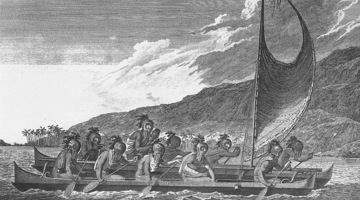Dr Pauline Harris (Victoria University of Wellington and Society of Māori Astronomy Research and Traditions – SMART) and David Perenara-O’Connell (Māngai, Tāwhaki Joint Venture) briefly explain Māori cosmological origins.
Names and whakapapa pūrākau differ from iwi to iwi. David makes reference to Raki, the sky father. Raki (or Rakinui) is also known as Rangi (or Ranginui) in other parts of the motu.
Jargon alert:
- Cosmology: the origins of the universe, its general structure and its evolution.
- Iteration: changing something to make a different version.
Questions for discussion:
- Cosmological origins have been an important part of human existence for thousands of years. What aspects of space origins are of interest to you?
- What do you think David means when he says that aerospace is the next iteration of a navigation journey?
Transcript
Dr Pauline Harris
Astrophysicist, cosmologist, kairangahau Māori
Senior Lecturer, Te Kawa a Māui – School of Māori Studies, Victoria University of Wellington
Chairperson, Society of Māori Astronomy Research and Traditions
In terms of how humans are related to the celestial, we know that Western – scientifically – all the different elements in our body come from stars. But for Māori, our whakapapa or our genealogy links us to the Sun, Moon and stars and the very beginnings of the universe.
Māori astronomy is really fundamental to Māori belief systems. It forms significant pillars of our whakapapa. So when we talk about Māori astronomy, we also have to talk about the very beginnings of the universe from a Māori perspective, which is our cosmological origins. So people will talk about Te Kore being – some will say nothingness – but more of a potential, going through aeons of development through various nights called Ngā Pō. And then the birth of consciousness, the formation of the Earth, the sky and all the stars and the planets and the Moon.
When you have a look at the whakapapa of the celestial, in terms of the relationship with humans, there’s lots of genealogies that explain how humans are related to various atua. Rangi and Papa had about 70 children including Tangotango and Wainui, and those two atua were the parents of the Sun, Moon and stars and phosphorescent light. And that is a version that comes from Tūhoe.
Those are the parents of the celestial, and in our other narratives from Māoridom, humans come from Tāne-mahuta. Tāne and Tangotango and Wainui are all the children of Ranginui and Papatūānuku. So therefore we – humans – are related to the stars.
David Perenara-O’Connell
Māngai, Tāwhaki Joint Venture
With regard to the connections for Ngāi Tahu, the story of Aoraki is very pertinent. Aoraki and his brothers, the sons of Raki the sky father, decided to come down in search of their father’s new wife, Papatūānuku. And so they met with her, and on completing their mission, they decided that they would return. Unfortunately, as the story often goes in our Māori pūrākau, they recited the karakia incorrectly and the waka – as it left the Earth returning to the sky – capsized and overturned and they clambered to the highest points of the waka and were ultimately turned to stone. Now our Ngāi Tahu tamariki today can trace their whakapapa right back to Aoraki and his brothers that connect us to creation.
Likewise for Taumutu and Wairewa – we have our tupuna Rākaihautū, the captain of the Uruao waka that came across the Pacific Ocean. And Te Waihora – one of its first names is Te Kete Ika o Rākaihautū, the fish basket of Rākaihautū. So again, our tamariki and rangatahi have direct whakapapa connection between their lake, named after their ancestor, who used the stars to navigate his way to Te Waipounamu. And so, there is that very real connection for them in the sense of their ahikā, their place of being, their mana whenua, and connection to this place through the efforts of navigation.
And turning our mind to aerospace, that’s our next iteration of a navigation story and a navigation journey.
Acknowledgements
Dr Pauline Harris, Victoria University of Wellington and SMART
David Perenara-O’Connell, Tāwhaki Joint Venture
Timelapses of night sky over Hoopers Inlet, Aurora Australis and Matariki rising above Aoraki Mount Cook, Dr Ian Griffin, Otago Museum
Dark starry night timelapse, Fraser Gunn
Animation of formation of world and the story of Aoraki and his brothers, Virtual Eye
Artwork of Rākaihautū by Cliff Whiting (ONZ), from Toitū Te Whenua Land Information New Zealand, Crown copyright, CC BY 4.0
Drone shots of Lake Waihora and Kaitōrete Spit, Tāwhaki Joint Venture
Gathering of shellfish from Lake Waihora and preparing tuna, from What is Mahinga Kai?, Environment Canterbury
Satellite image of South Island, NASA, CC BY 2.0



